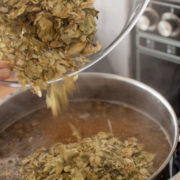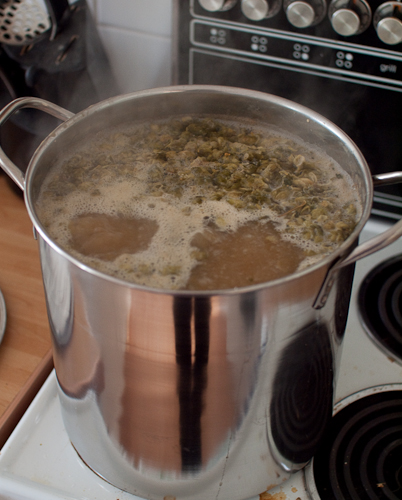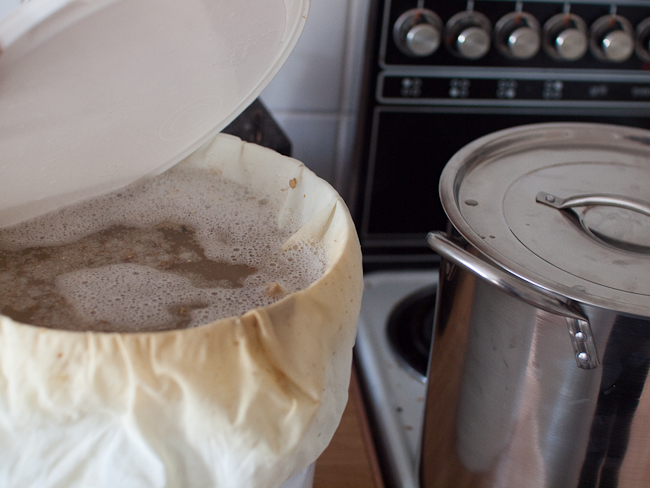Why You Should Start Small Batch Home Brewing
I’ll let you in on a secret of mine, a secret that has made me a better brewer sped up my understanding of ingredients, equipment and techniques of home brewing.
Brewing Smaller Batches Of Beer
I would say the most common brew length for a home brewer is 5 gallons, take a look at forums and recipes online and it seems everyone is brewing around 5 gallons consistently. I do brew around this amount most frequently but on occasion, I drop my brew length down to closer to 11 litres (3 gallons). In fact these smaller brew lengths are where I test a lot of the ideas about recipes I am formulating before making larger batches.
Let me give you a few of the reasons why I brew smaller quantities
Small Batch Experimentation – Brewing unique beers. I don’t want to brew 30 odd pints of a mint choc stout and find out after opening the first bottle it is an acquired taste (it was pretty good though). In the end, I brewed 9 litres or around 2 gallons and I enjoyed the brew day, it was quicker than usual and I was brewing something I wouldn’t have done otherwise. Since then I have been brewing more outlandish beers, using spices and flavours I wouldn’t have done otherwise. This brings me onto my next point.
Brewing More Often – This may just be me on this point. I found the brew day was a lot smoother and was slightly shorter, bottling didn’t take as long and was less of a chore and because of this I plan more recipes and look forward to the next brew day more and more. Some may argue that I need to brew more because I don’t have enough beer, however, my stock of beer is bigger than it ever has been.
It Takes Up Less Space – I do have all the equipment to brew up to 5 gallons at a time but that equipment takes up a lot of room and is kept in the shed. Brewing smaller batches enables me to stand around in the kitchen and boil on the stove in a large stock pot. I have a cool box mash tun that sits on the side and moving stuff around is so much easier. I live in a small place and in Cornwall it rains quite a lot, not having to brew outside means I can brew when I want, not when the weather permits.
Small Batch Brewing Equipment
This is where I see some major benefits to brewing smaller batches and a lot of equipment you might already have. Some people new to brewing may be put off having to get together the equipment to brew larger quantities so utilising a smaller brew length can have considerable savings.
Stock Pot – Most people have a stock pot right? Along with your basics (thermometer, spoon, colander, fermenting bucket/carboy) the only thing you really need to brew is a large pan. If you have a 6 litre/1.5 gallon pan brew a gallon batch. Work out your recipe for whatever size pan you have available. If you don’t have anything suitable a smaller stock pot is going to be a lot cheaper than a larger one.
With this one stock pot you can brew extract beers and steep grains as well as do full length boils with whatever hops you want, you can make most kinds of beer with nothing else.
Mash Tun – If you want to brew all grain then you need to mash your grains. Brewing smaller batches makes mashing easier and you can utilise methods that become more difficult the higher you grain bill is. Ever since I have started brewing I have used mash tuns in the following configurations:
- One fermenting bucket with lots holes drilled in the bottom inside another fermenting bucket with a tap to make a kind of false bottom.
- A mashing and sparging bag inside an insulated fermenting bin
- A mashing and sparging bag inside a stockpot, with this method you can do a multi-step mash with water infusions by sticking the pot on the stove. Be careful not to scorch anything, though.
- A cool box with a copper manifold or steel braid.
A few notes on brewing smaller quantities are that you will lose heat much quicker during a mash than in a 5 gallon batch so you need to think carefully about maintaining temperature. Also, you will want precise digital scales to weigh stuff like hops, spices and flavourings because in a small batch a little addition of ingredients can make a bigger difference.
If I were to recommend to someone who has never brewed all grain before a method to try, it would be to try a mashing/sparging bag (basically a nylon bag with coarse mesh on the bottom and extremely fine on the sides). I don’t know if these particular ones are available in the US but I have heard of people using paint straining bags to a similar purpose. The great thing about this method is it costs extremely little compared to buying or making a full-size mash tun and after a few batches you can then progress to a bigger or better mash tun. The idea of these grain bags is almost the same as BIAB (Brew in a Bag)
The Small Batch Home Brew Process
I have dedicated a whole article to the process of the small batch all grain beers. It’s a pretty long post but suitable for even the newest brewer who has never made a beer before. I strongly recommend you take a look even if you are familiar with all grain brewing. Check it out here.
This type of small batch mashing with a grain bag can also be very easy, especially when it comes to sparging, here is how I use a mashing bag to brew smaller beers. These instructions are for when I brew 9 litre/9.5 quart beers
- Take my 12 litre/12.5 US quart stock pot, fill it with my mash water (for my small brew length it’s usually 7 litres) and begin raising the temperature to 72°C/162°F.
- Once I hit strike temp turn off the heat and put the mashing bag into the stock pot and secure it around the top.
- Dough in my malt and stir thoroughly, take the temp which should be around 67°C/152°F and cover.
- Leave it for a 60 minute mash and take the temperature every now and again, if necessary you can turn the burner on low to keep a consistent temperature, just keep stirring though to avoid hot spots.
- After the 45 minutes, if you have another pot big enough begin heating sparge water if not don’t worry.
- After your mash, If you have heated sparge water in a separate pan, pull out the grain bag and let it drain thoroughly then dunk it in your sparge water and stir thoroughly (don’t squeeze it). This can be left for 15 minutes
- If you haven’t used another pan then once the mash is done pull out the mashing bag and let it drain thoroughly, place this in a bowl or tray to one side and pour the wort into a clean fermenting bucket. Recharge your stock pot with sparge water and heat to sparge temperature. Do the same as before, just dunk it in, stir around and leave for 15 minutes.
- Combine the first running and sparge wort in your stock pot and proceed with the boil. Empty your grain bag in the compost heap, no mash tun to clean.
- I want to point out that I do have a cool box mash tun but can’t always be bothered to use it. I have thought about converting a smaller cool box to use as a mash tun but I currently hit 74% efficiency using the mashing bag and end up beers of equal clarity to using my cool box (if you use a bag don’t squeeze all the wort out of it, you’ll end up with much cloudier beer).
- Some of you may scoff at this technique but if you haven’t brewed an all grain batch before I would suggest this method wholeheartedly, you can always upgrade to a mash tun for your second batch.
Brewing small batches like this is a great way to get started all grain brewing especially if you are short on space and equipment. The concepts and process are exactly the same as brewing larger batches so if you want to make the jump check out the All Grain Brewing Guide.
I do like the process of smaller batches, it feels like a lot less work and gives you a lot more freedom to try different things because you won’t end up with 5 gallons of experimental beer. Even if you are an advanced all grain brewer I would recommend you give a small batch of beer a go every know and then just to change things up.






Hi. In this small batch example, what is the volume of sparge water used? Cheers, David..
Depending on how much grain I am using in a particular recipe the sparge for my small batches in a 12 litre pot will be between 5 – 6 litres.
Cheers
Neil
Thank you Neil.